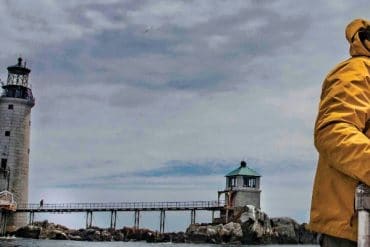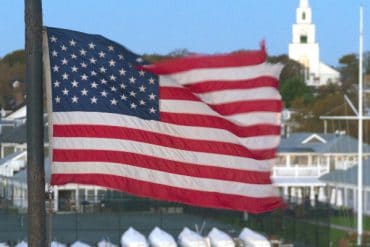 Anyone who has driven up Main Street in the past month has probably secretly wondered what it would be like if it was paved. This same thought was the center of a raging debate on Nantucket in 1919 when The Inquirer & Mirror championed the idea of tarring over Nantucket’s historic cobblestones. The debate centered around maintaining the charm of Nantucket versus the practical reality of maintaining the new automobiles driving on the island. So what saved the cobblestones from being steamrolled into the future?
Anyone who has driven up Main Street in the past month has probably secretly wondered what it would be like if it was paved. This same thought was the center of a raging debate on Nantucket in 1919 when The Inquirer & Mirror championed the idea of tarring over Nantucket’s historic cobblestones. The debate centered around maintaining the charm of Nantucket versus the practical reality of maintaining the new automobiles driving on the island. So what saved the cobblestones from being steamrolled into the future?
Save the cobbles! Save the town! Save Nantucket’s old renown! Turner doesn’t know his biz Save Nantucket as she is! That was the rallying cry of The Cobble, a newspaper published on Nantucket in September 1919. There was only one issue of The Cobble, and all four of its pages advocated a single cause: support for the cobble stones on Nantucket’s Main Street, especially the area between the Pacific Club and the Pacific National Bank.
Cobbles were first laid on the “business section” of Main Street in 1837. By 1852, they extended west to Pleasant Street. Be- fore the cobblestones were put down, the busy dirt road created dust or mud, depending on the weather. In addition to making the road more comfortable, the cobblestone paving helped lo- cal businesses. Carts carrying heavy barrels of whale oil could traverse the cobbled street more easily than along a dirt road, and the weight of the barrels caused less damage to the stones than to the soil, keeping the roads in better condition for longer.
In 1918, the condition of lower Main Street became a topic of public discussion. In the spring of that year, Nantucket’s long- standing ban on automobiles was lifted. Less than two weeks after the ban ended, twenty-four cars and a car dealership had come to the island. Nantucketers anticipated that the number of cars would continue its dramatic increase, and the suitability of the island’s roads for automobiles rather than horses became a concern. Lower Main Street, in particular, was acknowledged to be in poor condition. The question of what to do about the section of Main Street directly in front of the Pacific Bank, known as “the Square,” was also up for debate. Two alternatives emerged: Repave the road with cobbles or pave it with asphalt.
Supporters of the cobblestones argued that the island’s aestheic—the beauty and quaintness of its downtown and surrounding residential area—had a direct economic impact. Nantucket depended on its summer visitors, and the historic town center helped distinguish it from other seaside resorts. They argued that modern asphalt paving would look out of place with the hand- some nineteenth-century buildings fronting on Main Street, and that the higher cost of paving with cobblestones would be offset by the economic benefit of an attractive historic area that lured
tourists and continued to draw summer residents.
The attractiveness of the streets wasn’t the only aesthetic argument in favor of the cobblestones. Stately trees lined Main Street and contributed to the look and feel of the downtown area as well. Opponents of asphalt paving worried that an impervious road surface would affect their roots, ultimately necessitating removal of the trees. The Cobble included a statement by Professor J. W. Toumey, director of the Yale University School of Forestry, favoring a cobblestoned road surface because it allowed water and air to reach the roots.
Harry B. Turner was the editor of The Inquirer and Mirror in 1919. His support for paving with asphalt is well documented in the pages of the newspaper. In July 1919, he wrote of his belief that, even for summer visitors, comfort and convenience trumped the “uniqueness” of the cobblestones.
Cobblestone enthusiasts protested that Turner refused to publish their letters and gave too much coverage to the benefits of paving with asphalt. The Cobble emerged in this atmosphere as an alternative to the I&M’s coverage of the controversy. Its articles called out Turner by name and, while proclaiming that the editor had Nantucket’s interests at heart, declared him on the wrong side of the issue. An editorial cartoon in The Cobble, titled “The Child of Progress, or ‘From Baby Carriage to Steam Roller,’” depicted a paving machine labeled The Inquirer and Mirror pouring tar over Main Street, while small kneeling figures pleaded for leniency.
Advocates for retaining cobblestones on lower Main Street continued
to gather support. At its annual meeting, the Nantucket Civic League adopted a resolution declaring its “unqualified approval of keeping Main Street and the Square paved with cobblestones,” citing the centrality of Main Street to Nantucket’s image, the threat to the trees, and the fear of future “encroachments” on the business section of Main Street. Petitions collected the names of year-round residents and summer visitors who favored cobble- stones over asphalt. The Board of Selectmen asked if cobblestone supporters would be willing to finance repairs to the cobbled paving on lower Main Street, and funds were collected. Over the next several years, the cobbles in the business section of Main Street were slowly re-laid through private funding.
The cry to “Save Nantucket as she is!” has resonated over the years. In 1919, Harry Turner promised that lower Main Street would one day be resurfaced with asphalt, writing that “It may not be next year, or the year after, or the year after that, but it will be smoothed over some year—when the time arrives that common sense takes precedence over sentiment.” The publishers of The Cobble would be gratified to know that the year has still not arrived.





